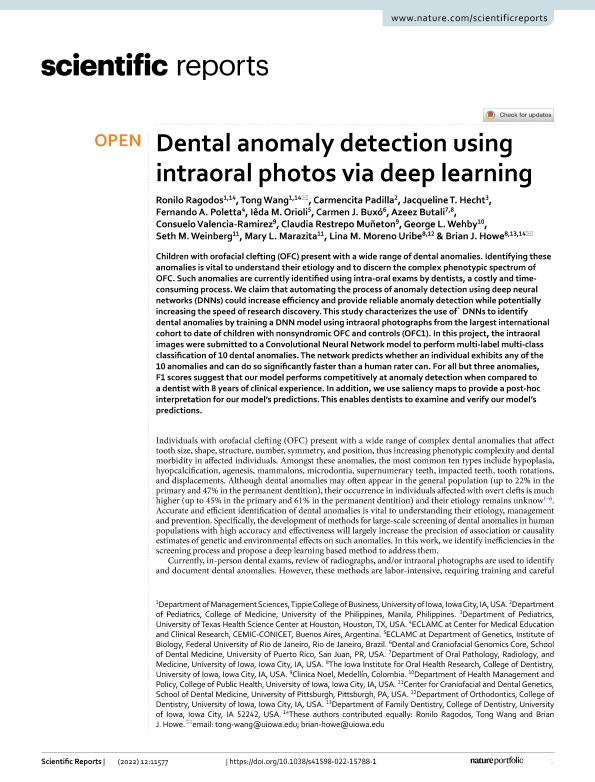Artículo
Dental anomaly detection using intraoral photos via deep learning
Ragodos, Ronilo; Wang, Tong; Padilla, Carmencita; Hecht, Jacqueline T.; Poletta, Fernando Adrián ; Orioli, Ieda Maria; Buxó, Carmen J.; Butali, Azeez; Valencia Ramirez, Consuelo; Restrepo Muñeton, Claudia; Wehby, George; Weinberg, Seth M.; Marazita, Mary L.; Moreno Uribe, Lina M.; Howe, Brian J.
; Orioli, Ieda Maria; Buxó, Carmen J.; Butali, Azeez; Valencia Ramirez, Consuelo; Restrepo Muñeton, Claudia; Wehby, George; Weinberg, Seth M.; Marazita, Mary L.; Moreno Uribe, Lina M.; Howe, Brian J.
 ; Orioli, Ieda Maria; Buxó, Carmen J.; Butali, Azeez; Valencia Ramirez, Consuelo; Restrepo Muñeton, Claudia; Wehby, George; Weinberg, Seth M.; Marazita, Mary L.; Moreno Uribe, Lina M.; Howe, Brian J.
; Orioli, Ieda Maria; Buxó, Carmen J.; Butali, Azeez; Valencia Ramirez, Consuelo; Restrepo Muñeton, Claudia; Wehby, George; Weinberg, Seth M.; Marazita, Mary L.; Moreno Uribe, Lina M.; Howe, Brian J.
Fecha de publicación:
12/2022
Editorial:
Nature Research
Revista:
Scientific Reports
e-ISSN:
2045-2322
Idioma:
Inglés
Tipo de recurso:
Artículo publicado
Clasificación temática:
Resumen
Children with orofacial clefting (OFC) present with a wide range of dental anomalies. Identifying these anomalies is vital to understand their etiology and to discern the complex phenotypic spectrum of OFC. Such anomalies are currently identified using intra-oral exams by dentists, a costly and time-consuming process. We claim that automating the process of anomaly detection using deep neural networks (DNNs) could increase efficiency and provide reliable anomaly detection while potentially increasing the speed of research discovery. This study characterizes the use of` DNNs to identify dental anomalies by training a DNN model using intraoral photographs from the largest international cohort to date of children with nonsyndromic OFC and controls (OFC1). In this project, the intraoral images were submitted to a Convolutional Neural Network model to perform multi-label multi-class classification of 10 dental anomalies. The network predicts whether an individual exhibits any of the 10 anomalies and can do so significantly faster than a human rater can. For all but three anomalies, F1 scores suggest that our model performs competitively at anomaly detection when compared to a dentist with 8 years of clinical experience. In addition, we use saliency maps to provide a post-hoc interpretation for our model’s predictions. This enables dentists to examine and verify our model’s predictions.
Palabras clave:
dental anomaly
,
oral cleft
,
deep learning
Archivos asociados
Licencia
Identificadores
Colecciones
Articulos(CEMIC-CONICET)
Articulos de CENTRO DE EDUCACION MEDICA E INVESTIGACIONES CLINICAS "NORBERTO QUIRNO"
Articulos de CENTRO DE EDUCACION MEDICA E INVESTIGACIONES CLINICAS "NORBERTO QUIRNO"
Citación
Ragodos, Ronilo; Wang, Tong; Padilla, Carmencita; Hecht, Jacqueline T.; Poletta, Fernando Adrián; et al.; Dental anomaly detection using intraoral photos via deep learning; Nature Research; Scientific Reports; 12; 1; 12-2022; 1-8
Compartir
Altmétricas



